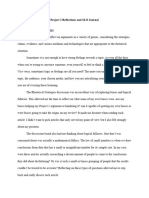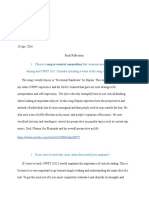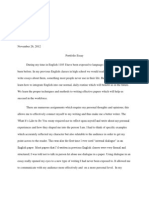Reflectionessayfinal
Reflectionessayfinal
Uploaded by
api-291683576Copyright:
Available Formats
Reflectionessayfinal
Reflectionessayfinal
Uploaded by
api-291683576Original Title
Copyright
Available Formats
Share this document
Did you find this document useful?
Is this content inappropriate?
Copyright:
Available Formats
Reflectionessayfinal
Reflectionessayfinal
Uploaded by
api-291683576Copyright:
Available Formats
Choi1
ChristineChoi
Writing39C
Prof.GregMcclure
29August2015
ReflectiveIntroduction
Over the ten weeks of taking the online Writing 39C class, I learned how to think and
write like a scholar, researcher, and a rhetorician. Before taking this class, I was extremely
nervous because I was not familiar with writing a research paper and I lackedthewritingskills.
WritinghasalwaysbeenachallengingcourseformesoIwasnotsureifIwouldbesuccessfulin
this class. However, I was worried for nothing because this class was more interesting thanany
of my other writing classes. The topic of my argument and research Writing 39C class was
loving animals and since this certainly caught my interest,Iwasmoreenthusiasticthanafraidto
write essays. Working on the Historical Conversations Project, SocialMediaCampaign,andthe
Advocating Project truly helped me learn differentwaystocreateandsupportastrongargument
withresearchinwritingandsocialmedia.
TheReiterativeProcessofCreatingaResearchedText
One thing I learned from this class is how the research process affects the creation of a
strong essay. When I first had to write a researched text, I mainly used Google as my research
tool andclickedonallthesourcesIfoundthatwerefairlyrelatedtomy topic, animalemotions.I
did not even check if they were reliable sources so I certainly did not research in depth. If they
were just relevant, I triedtoincludethemallinmyessay.Iwastryingtosqueezeallthe research
studies that I roughly researched in so my writing was repetitive and nonspecific.I realized that
Choi2
during theprocessofresearch,Imustresearchindepthandfullyunderstandthestudyinorderto
write a descriptive researched text. I also learned that arranging the elements in historical order
helps keep the essay organized. So from then on, I used Google Scholar and the online library
resources to find relevant articles and books. To review one literature in depth, I first searched
for the general topic using the terms such as animal emotions and chimpanzees grieving or
mourning. Then when I found an interesting study mostly in an article, instead of just blindly
using that one article as an evidence in my essay, I started to research in that particular study.
This grew my
curiosity to learn more about a specific topic. For example, while searching for
chimpanzees grieving and mourning, I found a research done by Tetsuro Matsuzawa in an
article. Matsuzawas study was briefly introduced in the article so I switched the focus and did
moreresearchonMatsuzawaandhisparticularstudy.
One research led to another research that was all related to each other. The terms I used
for research changed from animal emotions, chimpanzees grieving, Tetsuro Matsuzawa,
Matsuzawas study of chimpanzees, and the grieving of Jokro. This helped me find more
evidence that were descriptively written. Researchingindepthandreadingvariousliteraturethat
were focused on one study made me become an expert in the study I have researched. Since I
was first educated by all theresearchIhavedone,itwaseasierformetoexplainandanalyzethe
study in my essay. My
final draft of the HCP was written in depth with more analysis for the
pieces of literature I reviewed since I was more meticulous during the research process. This
helped me learn that the time and effort put in the research process results a well written
researchedtext.
Rhetoric,Argumentation,&MultimodalCommunication
Choi3
WorkingontwomultimodalcompositionsandtheSocialMediaCampaign,Iwasableto
experience how supportive an image is to an argumentation and persuasion. Multimodal
elements help readers visually understand the evidence or the problem. One picture is more
effective than awrittenexplanation.Forexample,ifreadersreadaparagraphfrommyfinalHCP
draft without any images, they would clearly understand my explanation but they would not
visualizethesameimageIamtryingtoexplain(
Figure1
).
Figure1:AnexampleofaparagraphinmyfinalHCPdraftwithoutanymultimodalelements.
But if an image, picture, chart, or a graph is included, I can effectively argue or persuade the
readers. The image included in my final draft
(Figure2)
,attractsthereadersattentionandhelps
themunderstandmyargumentmoreeffectively.
Figure2:AnimageincludedinmyfinalHCPdraft.
Choi4
The experience of planning andimplementingasocialmediacampaigntaughtmethatan
argument on new media platforms should be accurate and influential. The group name of our
social media campaign is PAFAC, which stands for People Against Farm Animal Cruelty. We
focused on the topic of animal cruelty on farm animals and spent most of our time researching.
We used
Facebook
as our main home base and used
Instagram and
Twitter as our other
platforms. Before posting anything on our media platforms, we made sure the information was
accurate and credible. I was especially careful on what I post on the media because throughthe
discussions we had in class, I learned how effective social media is in the society today.Apost
on the social media has the power to influence and affect ones life so I wanted to share my
knowledge of farm animal cruelty and motivate people to end such cruelty. Therefore, I mostly
made an argument that motivates the followers to take action while using an image as well. An
Instagram post below (Figure 3) is an example of how I made an influential argument to end
farmanimalcruelty.
Figure3:AnInstagrampostonourgroup'ssocialmediacampaignthatmadeaninfluentialargumentand
receivedonethemostlikesfromourfollowers.
Choi5
While working on the social media campaign, I was able to make an
engagement
through the learning of farm animal cruelty such as signing a petition and eating less meat. I
became
open to the idea of going vegan and actually tried to go vegan for at least a week
because I feltthe
responsibilitytofirst takeanactionbeforeaskingotherstodoso.Imaintained
the
persistence
to sustain the interest in animal cruelty and expanded my
creativitybycreating
ourown
infographic
forthecampaign.
During this writing class, I learned that there are significant writing styles for each
different genre. When writing for a
blog for example, I tend to write as if I were writing a
personal journal. It is not formally written nor isitstructuredinanessayformat.Itwassimplya
time for me to practice my
metacognition and honestly reflect on the progress I have made so
far. For a
literaturereview
,Ilearnedthatitisappropriatetoestablishtheauthorscredentialsand
thesis. So I introduced theauthor usingbiographicinformationandwroteabriefsummaryofthe
authors message before reviewing each literature. Imade suretokeepmywritingformalunlike
the social media post. The writing style for a social mediapostwasdirectandstraightforward.I
learned the textshouldberelatabletotheviewersandapproachasaconversationalwritingstyle.
The different style of writing was a challenge to me but through the practice of
flexibility and
adaptingtocertainplatforms,Ilearnedhowtobeacreativewriter.
AcademicWriting:ReviewandRevision
I would say my writing skills improvedthemostbythehelpof peerreviewandrevision.
During peer review, I was thankful that the reviewers pointed out the mistakesinmy essay.For
the first HCP and the AP draft, they pointed out how I lacked details and my writing was too
repetitive (Figure 4). These were the mistakes I did not see while writing the draft. I was also
Choi6
advised to rearrange the elements, focus on creating strong topic sentences for eachparagraphs,
and work on the transitions. I was recieved many helpful comments from my peers but I also
learnedalotwhilereviewingtheaccomplishmentsandmistakestheymadeintheirpapers.
Figure4:ScreenshotofhowtheprofessorandapeerreviewerbothmentionedtherepetitionandoverwritinginmyfirstAPdraft.
One thing I learned while reviewing others essay is the importance of an introduction.
After reviewing a peers essay that was well written, I realized that the introduction was more
specific compared to mine. Before the peer review, I only introduced the topic and social
problemofmyessayandthehistoricalcontextIwilluse(Figure5). Ididnotaddspecificsabout
what each paragraph will cover or the importance of my writing so my thesis was not strong
enough. Revising my introduction using my peers essay as a model, I wrote the best
introduction I have ever written so far (Figure 6). The introduction in my final HCP draft
describes each section of the essay which helped me strengthen my thesis and also keep an
organizedwritingthroughoutthepaper.
Choi7
Figure5:IntroductionofmyfirstHCPdraftwhereIlackedthespecifics.
Figure6:IntroductionofmyfinalHCPdraftwhereImadeanimprovementcomparedtothefirstdraftabove.I
explainedeachpartofmyessayandalsoexplainedtheimportanceandpurposeofmywriting.
TransferofKnowledgeandSkills
Now that I look back at the entire quarter, I am proud to say that I have made many
accomplishments as a writer and a researcher. In the beginning ofthequarter,Iwasnotfamiliar
with research as I mentioned before.Ididnotknowwhatkindofresourcesthereweretousenor
didIknowhowtoincludeoutsidesourcesinaresearchpaper.Butnow,asIcanseemyself write
argumentative sentences using research evidencetosupportmyclaims,IcansaythatIimproved
much as a researcher and writer. I will be using the knowledge I learned from the Writing 39
series in all of my future classesjusthowIusedit inmyAnthropologyclassthissummer.There
were several assignments where I had to write an argumentative or persuasive paper and the
Choi8
research and writing techniques I learned helped me receive a high grade. The multimodality
that I used in this class would also be something I would continue to use in other writing
assignments. Furthermore, just how good research comes from an open mind, I will continueto
keepmyheartandmindopentobecomeabetterwriterandperson.
You might also like
- Reflection Essay 1Document8 pagesReflection Essay 1api-291683576No ratings yet
- Reflection EssayDocument7 pagesReflection Essayapi-326115342No ratings yet
- Draft of Writing 39c Reflection Essay 1Document7 pagesDraft of Writing 39c Reflection Essay 1api-439832197No ratings yet
- ReflectionDocument2 pagesReflectionapi-508763071No ratings yet
- Reflection EssayDocument6 pagesReflection Essayapi-280419967No ratings yet
- Reflection EssayDocument15 pagesReflection Essayapi-291077403100% (1)
- Reflection Essay Revised DraftDocument5 pagesReflection Essay Revised Draftapi-279242501No ratings yet
- Final Portfolio ReflectionDocument6 pagesFinal Portfolio ReflectionMeagan BensNo ratings yet
- Rozita Gutierrez - Writ 2 Reflecitve EssayDocument4 pagesRozita Gutierrez - Writ 2 Reflecitve Essayapi-658679376No ratings yet
- Reflection Essay FinalDocument8 pagesReflection Essay Finalapi-291077403100% (1)
- Portfolio Essay Draft 1Document10 pagesPortfolio Essay Draft 1api-247584277No ratings yet
- Reflection Draft DoneDocument6 pagesReflection Draft Doneapi-733703712No ratings yet
- Reflection EssayDocument8 pagesReflection Essayapi-314230381No ratings yet
- Carlos Directo Writing 37 Professor Hass 3 March 2015 Final Refection EssayDocument5 pagesCarlos Directo Writing 37 Professor Hass 3 March 2015 Final Refection Essayapi-279200609No ratings yet
- Reflection 1Document3 pagesReflection 1api-681615884No ratings yet
- Final Reflection LetterDocument5 pagesFinal Reflection Letterapi-272676615No ratings yet
- Self ReflectionDocument14 pagesSelf Reflectionapi-256832231No ratings yet
- Slo 3Document2 pagesSlo 3api-697675168No ratings yet
- FinalreflectionDocument5 pagesFinalreflectionapi-316662316No ratings yet
- Reflection EssayDocument8 pagesReflection Essayapi-317395996No ratings yet
- Project 2 ReflectionsDocument9 pagesProject 2 Reflectionsapi-697411881No ratings yet
- Finalreflectionuwrt 1103Document5 pagesFinalreflectionuwrt 1103api-317334233No ratings yet
- Reflective Letter (Final Draft)Document3 pagesReflective Letter (Final Draft)Anonymous avxY1YHCgNo ratings yet
- (w37) Reflection Essay3Document10 pages(w37) Reflection Essay3api-281368432No ratings yet
- Reflection EssayDocument5 pagesReflection Essayapi-279233311No ratings yet
- Final Reflection Paper - English 1102Document13 pagesFinal Reflection Paper - English 1102api-248777156No ratings yet
- Alisha SquiresreflectionessayDocument3 pagesAlisha Squiresreflectionessayapi-223141951No ratings yet
- Reflection EssayDocument4 pagesReflection Essayapi-266336267No ratings yet
- Reflection Essay FinalDocument6 pagesReflection Essay Finalapi-279199102No ratings yet
- Reflective Cover Letter 1Document5 pagesReflective Cover Letter 1api-383551417No ratings yet
- Self Reflection PaperDocument4 pagesSelf Reflection Paperapi-252459127No ratings yet
- Reflective PortfolioDocument6 pagesReflective Portfolioapi-297062739No ratings yet
- ReflectionessayDocument5 pagesReflectionessayapi-279182234No ratings yet
- AldossaryAhmed Final LetterDocument3 pagesAldossaryAhmed Final LetterDaniel OlaleNo ratings yet
- Cover Letter - Tanisha LugoDocument2 pagesCover Letter - Tanisha Lugoapi-583267284No ratings yet
- Genre Portfolio Reflection Draft 2Document8 pagesGenre Portfolio Reflection Draft 2api-323754624No ratings yet
- Writing and Communication Mini Portfolio Essay Final Version 3Document1 pageWriting and Communication Mini Portfolio Essay Final Version 3api-656936473No ratings yet
- What I Have LearnedDocument12 pagesWhat I Have Learnedapi-356784962No ratings yet
- ReflectionDocument4 pagesReflectionapi-354422092No ratings yet
- Self-Assessment 1Document4 pagesSelf-Assessment 1api-534305334No ratings yet
- Portfolio EssayDocument6 pagesPortfolio EssayMitren ThakorNo ratings yet
- Reflection EssayDocument3 pagesReflection Essayapi-509512766No ratings yet
- Tong 1 Candy Tong Lynda Haas WR39C 30 August 2015 Reflective EssayDocument11 pagesTong 1 Candy Tong Lynda Haas WR39C 30 August 2015 Reflective Essayapi-291625031No ratings yet
- EnglishreflectionDocument3 pagesEnglishreflectionapi-300733544No ratings yet
- Relection Essay 2Document5 pagesRelection Essay 2api-273442638No ratings yet
- Reflection EssayDocument4 pagesReflection Essaymszeliga9279100% (1)
- SelfreflectionDocument3 pagesSelfreflectionapi-272482119No ratings yet
- Final Portfolio ReflectionDocument4 pagesFinal Portfolio Reflectionapi-254585912No ratings yet
- Jeanie Choi Reflective Essay Final DraftDocument5 pagesJeanie Choi Reflective Essay Final Draftapi-352282089No ratings yet
- Self AssessmentDocument3 pagesSelf Assessmentapi-507725488No ratings yet
- Portfolio Narrative StatementDocument8 pagesPortfolio Narrative StatementGuillermo CabreraNo ratings yet
- Fiiinallll ReflectionDocument9 pagesFiiinallll Reflectionapi-356117819No ratings yet
- Final ReflectionDocument4 pagesFinal Reflectionapi-300348577No ratings yet
- Self Assesment FinalDocument2 pagesSelf Assesment Finalapi-709429855No ratings yet
- Final ReflectionDocument2 pagesFinal Reflectionapi-710396108No ratings yet
- Reflective Letter FinalDocument6 pagesReflective Letter Finalapi-253009442No ratings yet
- Self-Assessment 2Document2 pagesSelf-Assessment 2api-709983183No ratings yet
- Eng 114a RelfectionDocument5 pagesEng 114a Relfectionapi-242946732No ratings yet
- Selfassessment NamelessDocument4 pagesSelfassessment Namelessapi-665807166No ratings yet
- Person-Centered/Client-Centered: Discovering the Self That One Truly IsFrom EverandPerson-Centered/Client-Centered: Discovering the Self That One Truly IsNo ratings yet
- United States Court of Appeals, Eleventh CircuitDocument17 pagesUnited States Court of Appeals, Eleventh CircuitScribd Government DocsNo ratings yet
- BTS Clinical Statement On Air TravelDocument22 pagesBTS Clinical Statement On Air TravelAli SemajNo ratings yet
- Study Guide No. 4 - Systems of Visual RepreseDocument2 pagesStudy Guide No. 4 - Systems of Visual Represeesmaadrian18No ratings yet
- Photochemistry and Pericy-Clic ReactionsDocument2 pagesPhotochemistry and Pericy-Clic ReactionsShardhaNo ratings yet
- Essentials For Nursing Practice 8th Edition Potter Test Bank DownloadDocument14 pagesEssentials For Nursing Practice 8th Edition Potter Test Bank DownloadJose Stepro100% (23)
- John Kanakanaka Lesson Plan RevisedDocument2 pagesJohn Kanakanaka Lesson Plan Revisedapi-282308167No ratings yet
- Bostrom Are We Living in A Computer Simulation 2003Document14 pagesBostrom Are We Living in A Computer Simulation 2003Tim KhamNo ratings yet
- 3V Physics - Lesson Plan - Nov - LopezDocument12 pages3V Physics - Lesson Plan - Nov - LopezMinorNo ratings yet
- 10 AAU - Level 5 - Test - Challenge - Unit 1Document4 pages10 AAU - Level 5 - Test - Challenge - Unit 1Silvia RovesNo ratings yet
- CW - Elements of PoetryDocument12 pagesCW - Elements of PoetryJhandy ElpaNo ratings yet
- Interview Question - Power BI-Part3Document5 pagesInterview Question - Power BI-Part3montoshNo ratings yet
- Belvedere Technical Teachers CollegeDocument2 pagesBelvedere Technical Teachers CollegeTanaka DandiraNo ratings yet
- Minutes 9-10-2010Document7 pagesMinutes 9-10-2010aswsuvNo ratings yet
- Tok Example 2024Document7 pagesTok Example 2024Mahira SajnaniNo ratings yet
- H0FL-S01100SN User's Manual V1.4Document45 pagesH0FL-S01100SN User's Manual V1.4AdeyemiNo ratings yet
- Margot Anand - Truth Is EroticDocument7 pagesMargot Anand - Truth Is EroticRazvan PopescuNo ratings yet
- 10.1 - Dangerous DrugsDocument19 pages10.1 - Dangerous DrugseuniceNo ratings yet
- RespiratoryDocument17 pagesRespiratorykurutalaNo ratings yet
- The Living Goddesses - Marija Gimbutas (2001)Document259 pagesThe Living Goddesses - Marija Gimbutas (2001)Ludwig Szoha100% (2)
- Classification Models For CYP450 3A4 Inhibitors and Non-InhibitorsDocument7 pagesClassification Models For CYP450 3A4 Inhibitors and Non-InhibitorsDP_AmethystNo ratings yet
- DR Ish Tee Bpo ResearchDocument77 pagesDR Ish Tee Bpo ResearchSumit ManchandaNo ratings yet
- Ejercicios Cap3 ProduccionDocument4 pagesEjercicios Cap3 ProduccionLuz De LunaNo ratings yet
- Hijo v. Mejares DigestDocument2 pagesHijo v. Mejares DigestElla Tho100% (2)
- Miso Soup For GERDDocument7 pagesMiso Soup For GERDRippie RifdahNo ratings yet
- Bolkiah Vs KPMGDocument15 pagesBolkiah Vs KPMGNurul AinNo ratings yet
- Open Nursery KinderDocument126 pagesOpen Nursery Kindermecaellamercado0No ratings yet
- Kalinga HouseDocument21 pagesKalinga HouseAddie WagsNo ratings yet
- Read The Text Below Then Do The Activities That FollowDocument6 pagesRead The Text Below Then Do The Activities That FollowVictor FrancoNo ratings yet
- The Extended Kalman Filter: An Interactive Tutorial For Non ExpertsDocument17 pagesThe Extended Kalman Filter: An Interactive Tutorial For Non Expertsmago876No ratings yet
























































































